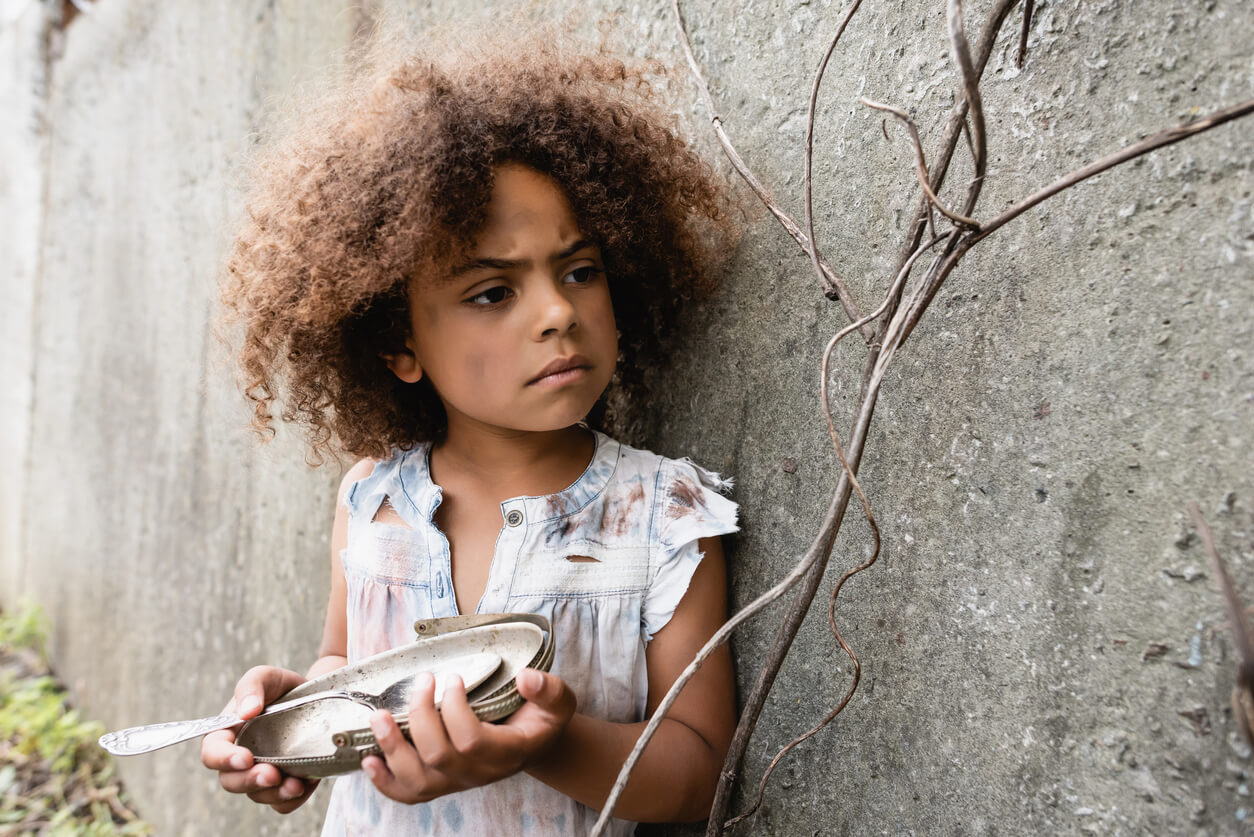This article includes studies from the U.S. & U.K. but acknowledges mental healthcare challenges worldwide. Please add to the discussion by posting studies from other countries or factors impacting mental health.

“Worrying about bills, food, or other problems leaves less capacity to think ahead or to exert self-discipline. So, poverty imposes a mental tax.“
– Nicholas Kristof, Pulitzer Prize-winning American journalist
The World Health Organization estimates over 300 million people suffer from depression, and most of these individuals reside in low-income countries. To imagine the stress a poverty-stricken individual may experience daily, one may constantly worry about food and housing insecurity, and living conditions, which eventually leads to a trauma response of being stuck in survival mode for people living at or below the poverty level.
Childhood poverty is intricately linked to traumatic experiences leading to a variety of mental health-related ailments. It is not only the adults of the lower socioeconomic category who are vulnerable to mental illness but also the children who grow up in such conditions. A Child and Adolescent Mental Health Survey conducted by the Mental Health Foundation in the U.K. reported that the prevalence of severe mental health challenges was three times more in children who belonged to the lower quintile of family income than those in the higher quintile. Such challenges hinder the cognitive development of children and adolescents, which negatively impact their education and life outcomes, often resulting in the continuation of generational poverty.
The distressing reality is that individuals who are in dire need of mental health treatment are most often the ones who are unable to access or afford it. Therefore, policymakers need to understand the relationship between poverty and mental health to help alleviate the problem so individuals can break out of this cycle of poverty and subsequent mental illness. MNDYRR aims to become an equitable holistic social services and mental healthcare tech platform that addresses the difficulties faced by the impoverished youth of today and provides them with the help they need to counteract them. Rather than focusing on alleviating mental ailments, which many apps address, MNDYRR acts as a social catalyst to bring communities together to provide existing services. By focusing on the social determinants of health to fill the widening gap, MNDYRR utilizes technology to embrace a community care model to address the complex needs of today’s children, youth, and families.
Which Comes First, Poverty or Mental Illness?
The relationship between poverty and mental illness has been the subject of ample research and studies in clinical psychology. While there is enough evidence to show a link between elevated mental health problems and low socioeconomic status, the causal nature of the relationship between mental illness and poverty generates curiosity. Does deprivation cause mental illness or vice versa? In some cases, is this relationship bidirectional? Some research suggests that two causal pathways link mental health and poverty; the social causation pathway and the social drift pathway.
Social Causation Pathway
According to this pathway, people who live impoverished have an increased risk for mental illness. Environmental stressors associated with poverty play a significant role when we look into this causal chain. Factors such as food and income insecurity, rising unemployment, lack of social support, and even global warming have been shown to impact mental health.
A couple of contributing factors to the social causation pathway include:
- Economic uncertainty: Natural disasters, global financial crises, epidemics, and pandemics can all result in economic uncertainty. Such situations create an overall stressful environment and can result in individuals undergoing long-term income volatility. Long-term exposure to such stress can result in mental health problems such as anxiety and depression.
- Increased exposure to crime and violence: Living in poverty can subject individuals to a life of violence and crime. Often, individuals within low socioeconomic households can experience domestic violence, especially toward women and children. Furthermore, some communities’ violent crime rates are relatively high due to poor living conditions and a lack of opportunity for upward mobility. This can result in traumatic incidents such as losing a loved one or being a victim of crime. Exposure to violence within the household and the threat of violent crimes can lead to depression and other serious mental illnesses.

- Social isolation: Amongst feelings of shame and humiliation, individuals living in poor conditions are marginalized, resulting in them feeling alienated and isolated and facing a lack of social connectedness with others in the society they live in. Feelings of loneliness are strongly correlated with mental illness as human beings’ social nature needs the support of others in their community to feel like they truly belong. Lack of social support can add strains to an already difficult life and can cause grave damage to one’s mental health.
- Poor physical health: Impoverished areas have an increased prevalence of physical health conditions of their respective populations related to malnutrition, poor living conditions, or polluted local environment. Unfortunately, having a low social-economic status also makes it difficult for individuals to access preventative healthcare services or even healthy food choices, which often leads to physical illness. Ultimately, the stress of high treatment costs and worries about severe and chronic health conditions cause a great deal of anxiety in individuals. Therefore, it is common for physical ailments to transpire with mental illness in lower socioeconomic areas.
Social Drift Pathway
Social drift refers to the pathway in which people already suffering from a mental illness tend to drift into or remain in poverty during the course of their lives. Individuals disabled by severe mental health conditions face many challenges that make it difficult to maintain stable economic conditions for themselves or their dependents.
- The stigma surrounding mental health: Due to the stigma attached to mental illness, many individuals face discriminatory attitudes from employers and are excluded from income-generating opportunities making it difficult for them to enter financial stability. These acts further worsen their financial status and can negatively impact their self-worth.
- Impaired cognitive functioning: Most mental disorders result in poor ‘occupational’ functioning, as highlighted in the DSM-5. Consequently, severe mental illness impacts an individual’s cognitive functioning and belief system, distorting their way of thinking about themselves and their abilities. Consequently, they cannot make sound economic decisions, find employment or perform well at their workplace. Their negative opinions about themselves overpower their judgment and act as a barrier to development.

- Healthcare costs: Similar to physical illness, treatment for mental illness can be very costly, especially in low-income countries with limited health insurance options. These unforeseen consequences results in individuals spending ample money on their treatment while simultaneously finding it challenging to maintain their financial conditions. High expenditures on health can further drain a person’s bank account, making it difficult to avoid entering poverty or improving their financial status.
The social causation and the social drift pathways show that the relationship between poverty and mental illness is bidirectional; economically disadvantaged individuals are at a higher risk of developing mental health problems, and mental health problems further negatively impact their ability to improve their financial conditions. Over time, individuals get stuck in a vicious cycle of poverty and mental illness, which continues unless they are provided equitable and affordable access to behavioral healthcare.
How Can We Help the Impoverished Improve Their Mental Health?
Many studies show that giving financial benefits such as cash payments, affordable health insurance, and other economically beneficial schemes in low-income countries can reduce stress and anxiety levels in individuals by offering promising alternatives to suffering. However, integrating economic interventions in low-income communities is a complex task and requires cultural reengineering, extensive planning, and research at the local, state, and federal levels.
While favorable economic conditions can improve mental health, research also suggests that mental health interventions can positively impact an individual’s financial stability. Treatments such as cognitive behavioral therapy (CBT) and other psychosocial therapies significantly improve economic outcomes for individuals with mental illness. They enable individuals to perform better at their jobs and improve their occupational functioning, pushing them towards attaining a sustainable standard of living and better life outcomes.
“Anyone who has ever struggled with poverty knows how extremely expensive it is to be poor.“
– James Baldwin (1924-1987), Prolific American author & Civil Rights era icon
At MNDYRR, our goal is to give at-promise youth a chance to improve, then maintain their mental health regardless of their socioeconomic status. MNDYRR is a safe virtual community space with a network of child and family welfare professionals always available to help and support. Equitable access to community resources combined with teletherapy can enable children to get the help they need to improve their quality of life. Links to their respective communities can provide the necessary hand-up services to overcome their plight. The goal is to ensure that no individual ever feels alone or isolated in their quest to improve their lives. The full-scale application will be released to the market by early 2023, but the beta version is available on Android, Apple iOS, and the web at mndyrr.com.
This article was authored by Dr. Maida Affan, an advisor to MNDYRR Technologies, Inc. For more info, please visit https://mndyrr.com/investor-relations/.





